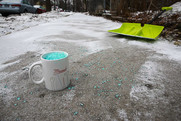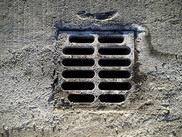How Much Salt Do You Really Need?

Over-salting is one of our most pressing environmental challenges in Minnesota. The excess road salt we use on our paved surfaces causes lasting damage to our rivers and lakes. In fact, one recent study predicted that by 2050, many metro-area lakes will no longer be able to support native aquatic wildlife due to this problem.
The MWMO works with our partners to train snow plow drivers and private contractors in smart salting techniques that help minimize this type of pollution. (We also recently helped Fridley buy smart salting equipment for their snow plows.) But residents can do their part too by being good neighbors and avoiding over-salting their sidewalks and driveways.
So how much salt should you use? WCCO-TV recently aired an excellent story on this topic. Here's a good rule of thumb:
A standard 12-oz. coffee mug filled with salt is enough to cover ten sidewalk squares or a 20-foot driveway.
Spread your salt granules wide, aiming for 3 inches of space between them. That may not look like very much, but using more won't help melt the ice faster. Also, double-check the effective temperature range of your specific ice-melt product, which likely contains more than one chemical ingredient. You can use this helpful chart to see which deicing chemicals work at different temperatures.
|
Use Sand When It's Too Cold for Salt to Work

Salt and deicing chemicals only work in certain temperature ranges. For example, salt will not melt ice below 15 degrees Fahrenheit.
You can use sand when it is too cold for salt to work. However, sand is still a common pollutant which can make the water murky, which harms fish, plants and aquatic life, so sprinkle just enough to provide traction on walkways. Sweep up any excess salt or sand after the ice melts so that it doesn’t get carried into stormdrains. You can toss the extra, or reuse it.
|
Mini Grants Info Session
Wednesday, January 15, Noon – 1:00 p.m.
Have an idea for promoting clean water and habitat in your community? Learn how to apply for a Mini Grant from the MWMO’s Stewardship Fund! Join us for this free information session, where you can find out more about the grant program, network with others and ask questions. Details…
Minneapolis Community Connections Conference
Saturday, February 1, 8 a.m. – 4 p.m.
The Community Connections Conference is an annual free event that fosters connections between the residents of Minneapolis, community groups, neighborhoods and local government. Stop by the MWMO table, grab a Good Neighbor Guide and tell us your priorities for our upcoming Watershed Management Plan update. Details…
|